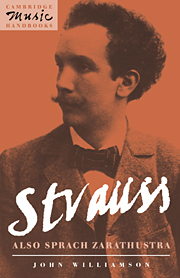2 - The Straussian tone poem as drama
Published online by Cambridge University Press: 04 August 2010
Summary
Strauss's career as a composer was already well launched when he aligned himself with the New German School (as the group around Liszt had been named). So pronounced had seemed his Brahmsian heritage that his conversion counted as a minor sensation. Steinitzer records this in his account of the critic Paul Marsop rushing up with the latest news, ‘Strauss has now become a Lisztian!’ In practice, Strauss's commitment to a Lisztian point of view was always qualified. It is evident that he prized Liszt's capacity to convey a certain tone by harmonic means, without the need of conventional contrapuntal techniques. This quality could be regarded as poetic, but was by no means confined to symphonic poems. Strauss was thinking of the oratorio Die Legende von der heiligen Elisabeth when he observed that Liszt's sense of poetry was not dependent on counterpoint, but he could also have cited those places in Mass settings where composers traditionally reached for fugal techniques, but where Liszt in his ‘Gran’ Mass instead sought to create through harmony and orchestration a mood in keeping with the text. Strauss would have connected such moments to the linking of ‘the triumph of harmony’ and expressive potential in the writings of his favourite aesthetician, Friedrich von Hausegger. Undoubtedly the idea of the poetic for Strauss was also dependent upon the nineteenth-century orchestra's greater range of tone-colour. This range Strauss sought to capture but not initially to expand.
- Type
- Chapter
- Information
- Strauss: Also sprach Zarathustra , pp. 10 - 19Publisher: Cambridge University PressPrint publication year: 1993



